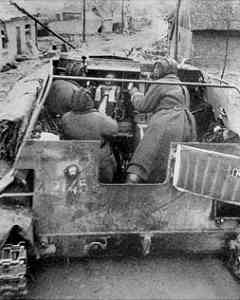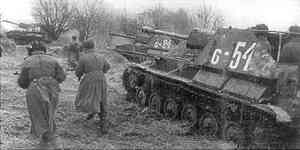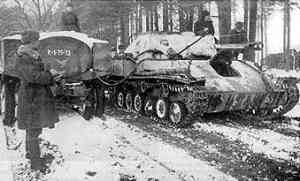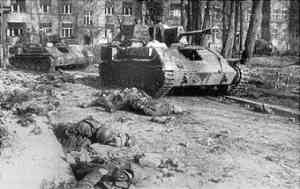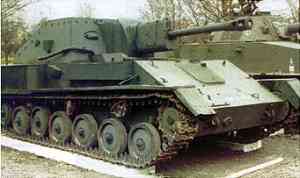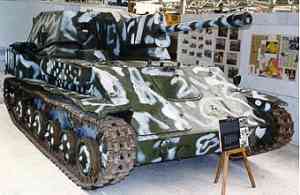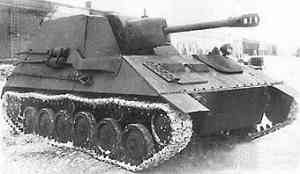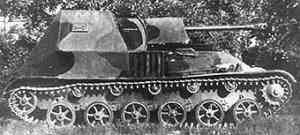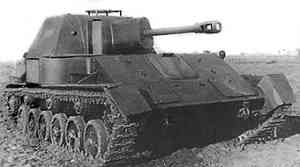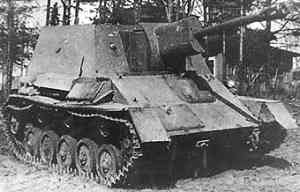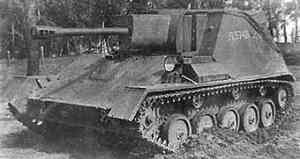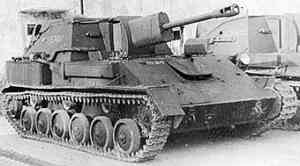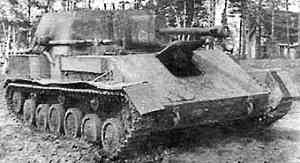When the Red Army entered the Second World War, the Soviet Union did not have any mass-produced self-propelled guns that could be used both for close support of the infantry and in an anti-tank role. In the late 1930's, a very limited number of SU-5 self-propelled guns was built based on the chassis of the T-26 light tank, but they only had limited use during the occupation of Poland in 1939.
By summer 1941, this lack of a suitable self-propelled gun appeared so serious that in September of that year, the ZIS-30 self-propelled gun was born as a stop-gap measure. Built on the chassis of the "Komsomolets" armored prime mover, this vehicle had a short range, had too much weight, and had poor stability, but it could reliably defeat anything that the Panzerwaffe had, which redeemed all of its shortcomings. In this way, the Red Army was provided with inexpensive self-propelled guns.
In the 1930's, there were some successful attempts at developing self-propelled assault and anti-aircraft guns on the chassis of the mass-produced T-26 light tank, which led to the manufacture of several experimental vehicles.
The SU-76P
With the arrival of new tank models, the T-26s could theoretically be converted to self-propelled guns, but in reality, conversion was impossible due to great T-26 losses during the first months of the Great Patriotic War. It was also impossible to replace the T-26s with new tanks due to the fact that the tank factories were being evacuated to the Urals and to Siberia. However, in besieged Leningrad in 1941 to 1942, several small batches of SU-76P were manufactured. The SU-76P consisted of a 76 mm regimental field gun installed on a T-26 chassis with a circular field of fire, and it had no protection for the crew other than the gun's shield. But this vehicle was merely another stop-gap measure, as the besieged city had to make do with whatever equipment it had remaining inside the encirclement.
In autumn 1941, all tanks armed with 45 mm guns which fought on the Leningrad Front become useless against "soft" targets like infantry due to the lack of fragmentation and high-explosive ammunition. That's why the General Staff of the Leningrad Front asked the Ministry of Tank Industry (NKTP) to rearm existing BT and T-26 light tanks with the 76 mm KT Gun.
A new vehicle was developed and tested, and after successful testing, the General Staff of the Leningrad Frond ordered Factory #174 to start manufacturing the new self-propelled guns. This vehicle received the SU-76 designation, and from 1943, it was renamed the SU-76P (P - "polkovaya" - "regimental") to avoid confusion with the new self-propelled gun which had the same designation (see below).
The OSA-76 (OSU-76)
The SU-76P alone could not solve the Red Army's lack of self-propelled guns, and there were attempts to utilise the chassis of T-60/T-70 tanks, which were mass-produced in 1941 to 1943. In autumn 1941, the GAZ Factory began, on its own initiative, the development of a light self-propelled gun designated the SU-71. However, it never entered full-scale production. By July 1942, another self-propelled gun was developed: the OSA-76, which was based on the chassis of the T-60 tank.
That project was developed by an initiative of GAU, which involved the idea of installing all field artillery on self-propelled chassis. An "OSA" designation means "Obshevoiskovaya Samokhodhaya Artilleriya" (All-Purpose Self-Propelled Artillery). In fact, OSA does not belong to the SU-76 series, as it was rather an independent class of self-propelled guns. The whole OSA project resulted in the development of the following partially-armored vehicles:
- the OSA-76 - a partially armored vehicle with a 76 mm self-propelled gun;
- the OSA-57 - a partially armored vehicle with a 57 mm self-propelled antitank gun;
- the OSA-23 - a partially armored vehicle with a 23 mm self-propelled antiaircraft gun;
- the OSA-12 - a partially armored vehicle with a 12.7 mm self-propelled antiaircraft gun.
The OSA-76 was armed with the 76.2 mm Assault Gun ZIS-3Sh based on the 76.2 mm Divisional Gun ZIS-3. The vehicle had a very low weight - less than 3,500 kg. The GAZ-MM gasoline engine powered it. The chassis of the OSA-76 was the same as on the T-60/T-70 light tanks. It had a crew of three men, and the armor protection was 6 mm. The OSA-76 successfully passed all tests and was recommended for mass production, although it was ultimately never produced.
An attempt by Rumanian engineers to install a captured 76.2 mm F-22 gun on the chassis of a captured T-60 tank was more successful. Until the arrival of the German Pzkw IV Ausf G, they were the only means to reliably defeat Soviet medium and heavy tanks.
The Self-Propelled Gun of Factory #37
This was a self-propelled gun of the SU-76 series. The development of this vehicle followed the NKAP order of March 3, 1942. By May 1942, the first experimental prototype was manufactured and sent to the proving grounds. However, neither the chassis nor the armament passed the trials. The construction of this vehicle was based on the chassis of T-60 light tank.
The SU-12 (SU-76)
On October 19, 1942, the GKO issued Document #2429ss which ordered the GAZ Factory and Factory #38 to develop, to test, and to put into full-scale production a light SP gun, armed with the 76.2 mm Gun ZIS-3. The new vehicle was based on the chassis and engine of the T-70 tank, but with increased length, and an additional road wheel.
In November 1942, both factories showed their prototypes. Both vehicles were armed with the ZIS-3Sh ("Sh" means "shturmovaya" or "assault") gun. The GAZ project was named the GAZ-71, and Factory #38's project was named the SU-12. On December 9, 1942, after comparative trials, the GAZ-71 was recognized as "not conforming to existing battle requirements," and was "very unreliable;" and thus, further work was cancelled. The SU-12, however, was accepted for service under the name "SU-76 Self-Propelled Assault Gun." From January 1, 1943, mass production began.
The designers put the two GAZ-202 engines parallel to one another instead of in-line as on the T-70 tank. Its fully-enclosed shielding was welded from 10 to 35 mm armor plates, the driver's compartment was located in the front of the vehicle in between the engines, while the superstructure housing the ZIS-3Sh gun was located in the rear.
The crew of three also had a DT machine-gun and personal firearms at its disposal. By the end of January 1943, it formed the first two self-propelled artillery regiments sent to the Volkhov front.
The SU-76M (SU-12M)
The shortcoming of the parallel engine placement in the SU-76 (SU-12) became apparent when it resulted in transmission malfunctions. The malfunctions were due to torsional vibrations which led to rapid breakdowns. The vibration peaked in second gear, which was the most overloaded gear. It was impossible to properly synchronize the two engines.
As a result of the experiences in the field, the production of SU-76 was halted on March 21st, 1943, after only 350 were produced. Due to the planned summer offensive, the GKO put a very strict time-frame to correct the defects. Already by May 17th, 1943, an updated SU-76M (SU-12M; M means "modernised") entered testing and by June of that year it entered production.
These vehicles had updated engines and transmissions, and used the old SU-76 hulls that were left over. Improvements included the introduction of spring clutches between the engines and the main gear, of a slipping clutch on the general shaft, and of engine shock absorbers. These items reduced, but did not eliminate, the likelihood of a malfunction. In May 1943, the production of the SU-76M began. All of those vehicles took part in the Battle of Kursk.
The SU-15, the SU-16, and the SU-38
By summer 1943, the design bureaus of the GAZ factory and Factory #38 offered several independent projects on how to modernise the SU-76. GAZ offered the GAZ-74A project, which was to use the Soviet ZIS-16F or ZIS-80 diesel engines, or the American "Giberson" engine (of 110 hp). It was to be rearmed with the more modern 76.2 mm gun S-1, but the project was abandoned, and only one experimental vehicle was built.
Factory #38 simultaneously offered three different projects: the SU-15, the SU-16, and the SU-38. All these vehicles were to be armed with the 76.2 mm Gun S-15, and they were powered by the GAZ-203 engine (like the T-70 light tank).
The SU-15 was based on the chassis and hull of the SU-12, and was powered by two GAZ-203 engines, and with the slightly improved air-filtering system. The compartment (superstructure) was slightly widened.
The engine, the transmission, and the chassis of the SU-16 was originally taken from the T-70 light tank. However, the protection was increased with 45 mm armor on the front. The compartment was armor-protected from the top and rear as well.
Like the SU-16, the SU-38 self-propelled guns had the chassis and engine taken from the T-70. However, this vehicle was much lighter than the SU-16. It had an all-around protected compartment at the front of the tank (like the SU-152, etc). It was engineered to distribute the load evenly along the chassis.
Comparative trials were performed during the summer of 1943. They showed that the SU-16 was the most successful, but had a poor crew layout. The chassis of both the SU-15 and the SU-38 were overloaded, which led to rapid breakdowns. Nevertheless, the SU-15 was chosen and recommended for mass production after a weight decrease.
The SU-15M (SU-76)
While producing the SU-76, the GAZ factory started a modernisation program for the SU-15, as all the critical parts of that vehicle (engine, chassis, transmission, etc) were produced there. The modernised self-propelled gun (factory designation SU-15M) was distinguished from its predecessor by the unprotected compartment from the top and rear. It was powered by two GAZ-202 engines with a common cooling system and transmission.
In August 1943, that SPG successfully passed all trials, and was accepted for service under the SU-76 designation. From October 1, 1943, the mass production of this vehicle began.
|




